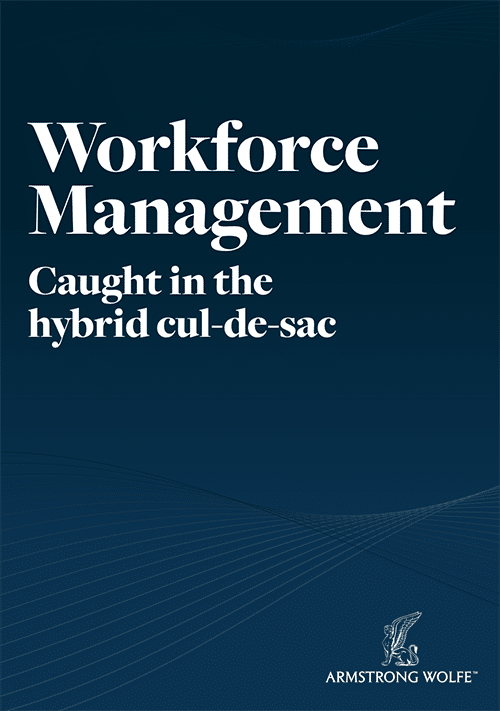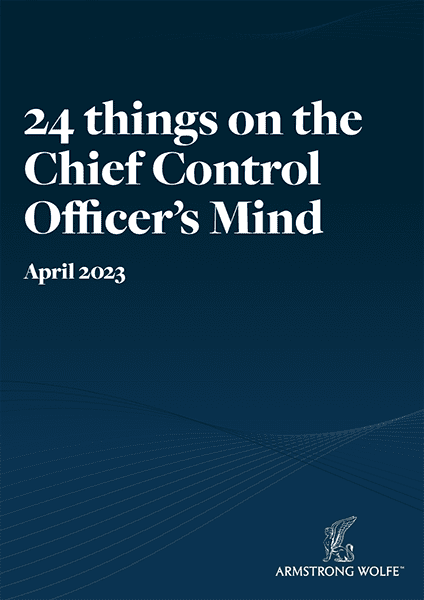“My argument is that women in the COO community add equal or greater value in the COO role than men, so more should be done to promote and retain female COOs.”
Maurice Evlyn-Bufton, CEO Armstrong Wolfe
WOMEN IN THE COO COMMUNITY
The commercial case for equality-plus representation
I have always felt that women make more effective COOs than men but have been hesitant to state this openly, fearing that my views on commonly associated behavioural skills such as influence, empathy, collaboration, integrity and so on would be seen as clichéd or stereotypical. I also struggled to know how best to express my feeling that women also make for a highly effective number two, supporting a principal executive (whether that principal is a man or a woman). Women seem frequently to demonstrate a selfless commitment to a common and overriding goal and this, of course, is a key attribute for a COO.
I have researched this matter extensively and have heard my suppositions tested with hundreds – if not thousands – of references to the capabilities of women, sometimes in the form of passing comments and at other times as exact and targeted observations or official references. The conclusion I have reached is that there is a straightforward commercial need for women to be found in the COO community in equal, perhaps even in greater, numbers than men.
Any analysis of this subject, however, must be carried out in the context of the banking COO specifically, as this can differ substantially from the same position elsewhere. Even within the banking sector, the role and responsibilities of the COO can vary due to the proliferation and liberal distribution of the COO title in recent years. The execution of the COO’s job can be very different within the front office itself, let alone from the same role by title in the infrastructure (although some of the workload may be comparable). As one infrastructure COO put it:
“There are two types of COOs in the front office. There are those with a risk, finance, operations or product control background. Here their role tends to be aligned to their heritage, such as risk management, expense management, regulatory oriented or project focused, and then there is the minority where you really are the right-hand man or women of the CEO. … The career tracking is different and they need to think more consciously about the skill-set they have. … I think the issue around low numbers of women in these roles starts at the point of recruitment at the more junior levels, making sure there is a more defined career path and support.”
My research covered all COO roles, in a variety of regions and functions. The results showed that in all areas, there was a constant challenge to demonstrate equality – and sometimes even basic representation – at the leadership table. During my research I read many sources. One in particular is worthy of mention here: a Harvard Business Review paper titled ‘Are Women Better Leaders than Men?’ (Jack Zenger and Joseph Folkman, 2012.). This is not specific to the COO, but many of the competencies it assesses are found within any COO role. This paper inspired several of the questions I put to female COOs in my own research, all linked to the central question, “Do women make better COOs than men, and if so, why?”
One of my contacts, who has held executive positions in various functions and disciplines within banking and who has more recently moved into a COO role supporting a group CFO, summarised her thoughts on this matter:
“I have seen very good male and female COOs and poor male and female COOs. I don’t agree therefore that women have innate competencies that make them better in this role. However, I do agree that there are fewer female front-office COOs than there could be, and that’s largely a function of the ratio imbalance of men to women in the front office generally. It also depends on the role. If it is [seen as] a stepping stone in a front-office context, then the female (or any) COO will need to have a demonstrable revenue track record – and here specifically this group of women is much smaller.”
It was with this initial feedback that I approached a number of female executive COOs for their thoughts.
Question 1
Do you believe that women make better COOs than men?
I deliberately began with a yes or no question, although I expected anything but simplistic answers. In truth, the question is not so much whether women make better COOs, but rather why they do (or don’t) and why they might be perceived as a better fit than men. In such a complex role, assessing the common responsibilities of the COO would help determine the answer.
Common themes are the nature and demands of the role. This is a full-on, often 24/7, job, which can make it difficult for women with family commitments. I know that many people will disagree, claiming that this factor is no longer relevant, but a reasonable percentage of the women asked raised this point. Some women have a partner whose own commitments allow her to be at the end of the phone to deal with issues as they arise, but this is not always the case.
A few women suggested that there are still remnants of old fashioned attitudes that work against women. One commented: “Many COO-to-manager relationships have been cemented in social interaction in the bar, [but] I can hardly see myself popping my head around the corner of my boss’s office saying ‘shall we grab a beer tonight to cover a few points?’” Such attitudes can challenge equal opportunities. Demands of the role such as long hours are being addressed by policy and cultural change, but in reality most people accept that being a COO means allowing others constant access to you. One can only hope that the office-bar dynamic is a legacy of the past that will fade with the rise of a new managerial generation.
It is the behavioural differences between men and women that really strengthen the case for women making better COOs. While some of the women interviewed gave a straight ‘yes’ or ‘no’ answer to the question, most carved out a diplomatic path, which in itself suggests that women may be better suited than men to such a role:
“Top-level COOs have tended to be male and have been selected for the role based on previous roles of being No. 1/head of a front office/sales type division rather than coming through the ranks in a more business manager/strategy-type role. In this observation, I would say that the people selected have had the strategy and leadership strengths analogous to the No. 1 (e.g., the CEO), but not the No. 2 (COO) attention to detail/ follow-through/multi-tasking skills that may, at face value, be a more generic female trait. By the same token I would say that if you see the CEO/COO balance to be that the former sets the agenda and the latter executes the agenda, then the COO would also require the more strategic/ killer instinct to effectively cascade down and drive forward the agenda. I wonder therefore if it’s the next level down that … tends to capture the more stereotyped ‘female’ trait people.”
GLOBAL COO, CLEARING SERVICES
“I think it depends upon the individual. No two COO roles are the same, and therefore, the skill-set needed varies. I think there needs to be more gender balance in the COO community. It is difficult for a woman to excel in this field when the definitions of success often still link back to old-fashioned traditionally male traits such as working long hours, networking in the bar etc. rather than what is actually delivered.”
COO TO CHIEF CONTROL OFFICER
“I think women make better COOs because the job of the COO is never done and women don’t naturally do the least they can get away with – they are naturally diligent and seek to please their bosses – I am of course generalising to make a point, for impact.”
EMEA COO, MARKETS
“No. I think this is not a gender question, but a skill question. In my experience as a COO and employing junior to senior members of a COO team, I have found both men and women to be equally capable and equally incapable of performing as a high-functioning COO. The only place … where perhaps you could argue that gender plays a part is in the “softer” and sometimes necessary skills that come with parts of some COO roles. Some examples include having that innate intuition or pulse of the employees, or, in finance, which is still heavily male dominated, be a natural point person.”
GLOBAL COO, DISTRIBUTION
“More often than not women are better at multi-tasking, they are more organised and think beyond just themselves, by considering the potential impact that something can have on others and the broader community as well. Women are also intuitively more practical, and so will consider the practicalities of implementing a process or control as well as focusing on the end result. All these qualities or skills are very relevant for a COO and can often differentiate between a successful COO, who progresses and adds value to organisation, versus someone who enjoys the title but is unable to accomplish what is required. Someone once said to me that a successful COO is someone that is comfortable and also happy to be the No. 2. … I think women often feel comfortable in that position [while] men will often struggle – perhaps it is an ego thing, or a sense of over-confidence that kicks in.”
CHIEF OF STAFF TO GLOBAL HEAD OF EQUITIES
Question 2
Other than well-established issues such as insufficient support for those with families, shortcomings in equitable promotion and pay, etc., what factors unique to the role of the COO inhibit career progression for women?
It was universally acknowledged that the challenge for women to gain equal representation in opportunity and career advancement was no different in this role than in any other in banking. “I do not think that any of the issues are specific to COO roles”, commented one. All the principal banks are operating and working on their equality agenda, albeit at different paces and with varying results. “We will have to therefore work on both sides, reducing the costs through flexible work arrangement and increasing the benefits through genuine development plans that make career progression a reality.”
However, my argument is that women in the COO community add equal or greater value in the COO role than men, so more should be done to promote and retain female COOs. The question should therefore be, “What can be done over and above what is already being done?”
Although I could find no reliable data to confirm it, there do seem to be more women than men in visible leadership positions within a COO role. This may be because the COO role “offers the ability to do things like work flexibly but still be in a front office environment”, as one woman questioned suggested. My own research suggests that 25–30 per cent of banking COOs are women, but this of course does not present the full picture of female leadership in banking. For that you need to consider the ratio of men to women as business heads alongside the ratios within the COO community.
Conversations on this subject were diverse, and opinions and proposed solutions varied. Evidence that establishing equal, or near-equal, female representation at COO level pays commercial dividends would help this cause, but the ambiguous nature of the COO role makes this a qualitative and not a quantitative assessment and, thus, hard to prove:
“The fact is that there are not enough mid-level female managers in banking overall. Statistics show that whilst women make up 50 per cent or more of the junior positions, the proportion of women decreases at each level as we move up the hierarchy. Women are exiting at higher rates than men, and they are being hired at a lower rate. For women the costs of working in the financial industry still seem to outweigh the benefits; as a result they leave the industry.”
GLOBAL COO, UK WHOLESALE BANK
“I don’t necessarily think there is anything explicit that is lacking to enable more women to take on the roles of COO. Unfortunately, I think the same issues that are discussed in all organisations around female leadership, progression, unconscious bias, networking, political savvy all ring true, and organisations can only do so much to change those factors both within the organisation but also within women themselves. I think for women ‘mentoring’ is a big factor in terms of developing the skills to step up the ladder. Women need that nod of approval more than men in order to put their head above the parapet. I think this also goes to being in the ‘inner circle’ to be selected for roles, particularly higher up the chain. The harsh reality is that people like to select people who they know, who they have worked with, who they trust and too often who are like them. For a number of explicit as well as implicit reasons, women tend to both be excluded and exclude themselves from this inner circle.”
GLOBAL COO, FUTURES AND OPTIONS
“As the relationship between the business leader and COO needs to be highly effective for it to be of value, often COOs are picked from a pool of people the business leader already knows. As the majority of the front office is male, they will only have a small pool of female candidates to pick from. Even when a female is appointed to a COO role, people will assume it is more administrative in nature than when a male colleague is in a similar role.”
GLOBAL COO TO CHIEF CONTROL OFFICER
“I don’t see structural problems that hinder women in the COO space particularly. I would say that rather this is one of the areas where you tend to see more senior women because the COO role offers the ability to do things like work flexibly, but still be in a front-office environment. My COO staff is over 30 per cent female at all levels – this is way above the female participation rates in other front-office areas.”
EMEA COO, MARKETS
“I think it is an excellent role for a woman and can complement a women’s skill-set incredibly well. Perhaps to achieve senior success as a COO, though, a woman needs to be extremely driven (which can often be the case) – but also be prepared to push very hard to take things forward. Not afraid to deal with some extremely tough situations. … Let’s not forget that a COO is not a glamorous role. It requires quick thinking and a very self-assertive attitude to get things done. … I do think that this aspect of the role can be daunting to anyone, and maybe more so to a woman in a very male environment – so a successful female COO will need to be confident to work through all aspects of the role with determination and grit. They might need to work harder than their equivalent male – but actually I also think it’s about working smarter.”
CHIEF OF STAFF TO GLOBAL HEAD OF EQUITIES
Question 3
What could be done specifically within the COO and business management community to address the shortage of low female representation at the mid to senior level of this community?
This question dovetails with Question 2, but interestingly the answers were more direct and pointed. Those interviewed seemed to understand that behavioural development and building confidence in female COOs would be a good start in establishing a stable of talent for the future: “Resilience is key; whatever we can do to help women build this reliance will make a difference.”
Aligned to this is a need to improve the perception, understanding and awareness of the COO role at an early stage in someone’s career. Such steps are necessary in order to attract the best men and women into this community. They demand a path for advancement within the business management community and managers willing to invest in their staff’s development. “If they don’t have a decent line manager, a sponsor or structure around them that can nurture, provide support and answer important questions, how can you expect someone to be successful?” This is particularly true of women who want both a successful career and a family.
Developing an effective and well-supported return-to-work policy for women who have taken time out for family, married to a strong culture at all levels of embracing such choices, will in time help to address the issue of inequality in female representation in the COO community. I believe it is easy to accommodate a workplace/ home working structure and to allow opportunities for job sharing. In addition, women with years of previous and varied experience can often be welcomed back into a business management function, allowing them to rapidly refamiliarise themselves with the market. The return on this investment, commitment and cooperation will be in establishing a more representative and effective business management function. This is more relevant today than ever, especially when good conduct, behaviour and culture are at the forefront of any CEO’s and COO’s agenda:
“I don’t think there is anything different for the COO space than there is for the rest of the financial industry. A career in the financial industry is hard and can be exhausting in the long run, both for men and for women. We need to make sure the benefits are as attractive for women as they are for men.”
GLOBAL COO, UK WHOLESALE BANK
“I don’t think someone in a mid- to senior-level COO role within a firm is necessarily the person who becomes the company COO. Perhaps this leads to a gap in certain types of leadership skills, strategy-based skills more commonly needed in the CEO No. 2 role. By the same token the CEO No. 2 can lack the more detail-driven competencies acquired through non-P&L generating functions. Perhaps some networking forums around both the skill gap closing and the education of the space may help to close the gender gap. Certainly, I think the COO space at any level is one that people fall into rather than actively aspire to, simply through lack of understanding or awareness of the space.”
GLOBAL COO, FUTURES AND OPTIONS
“Remove the need for so much self-promotion from the promotion process. Often people who talk about delivery and who actively network are promoted, as they are deemed to have ‘presence and gravitas’. This disadvantages women who generally (but not exclusively) prefer to be judged on their work ethic and what they have delivered and will actively try not to ‘brag’.”
GLOBAL COO, CONTROL AND CONDUCT
“There is not one magic answer, but I do think that there is some key, consistent practises that can move us towards one day seeing more woman at the mid to senior level. First off, though, why do women derail from what looks like a promising career path? … I think women (in finance) in COO roles (just like other roles) tend to not have the network and informal mentoring that is needed. Firms need to continue to identify the high potential (female) talent early on and embrace them, help them build their network, give them senior sponsors. Senior women also need to view it as their responsibility to be a voice to support these women as well. At the same time middle (male) management needs to be trained on unconscious bias behaviour.”
GLOBAL COO, FIXED INCOME
“Often I think that juniors to mid-level females become disillusioned as they start to progress if they don’t have a decent line manager, a sponsor or structure around them that can nurture, provide support and answer important questions around how you be successful in your career as a woman and also start a family. A lack of support at this stage can encourage females to either move out of the industry or when they do start a family, decide that they can’t return to work. … Females have a range of different needs when they are at work, but often they need to be encouraged to put themselves forward for roles. A female is often more likely to think that they can’t do a bigger role, whereas a guy will think he can do a bigger role, even when he may not be experienced or ready for it. The lack of confidence with the female can inhibit progression, but can actually quite easily be overcome through support and sponsorship if implemented at the right time in a female’s career. … I have seen so many talented junior females enter the COO/business management community – and if we can do a better job to nurture and support them right from the start and make sure that their line managers are also trained to effectively do the same, then I think that over time we will have better female representation at the more senior level as well.”
FORMER GLOBAL COO, EQUITIES
So, is there a commercial argument and moral case for greater female representation in the COO community? Yes. Do women make better COOs than men? Yes. Is this my opinion and that of the majority asked – having surveyed both men and women? Yes. Naturally, women do not want quotas; they want to be promoted on merit. The challenge for women, especially within the front office, is finding the opportunity to demonstrate they are worthy of such promotion. The issue is threefold:
1. How do you attract the best women into business management, develop and retain them?
2. How do you structure an effective return-to-work programme for those who have taken a career break to start a family?
3. How do you create a platform of equal opportunity and visibility for women in the COO community, especially in the male dominated front office?
If I were a CEO (or king for a day!), my aim would be at least equal representation of women and men within my COO team – not to fulfil a quota but to maximise commercial performance. I have drafted my speech to my fellow and fictional board members as such:
“Let us start with an objective of 35 per cent – at least that is a step in the right direction and one that is achievable if we combine the steely determination of the female COOs and business managers we have already with those who we will identify and nurture for tomorrow, and combine their will and commitment to the task, knowing they have a boss, a management team, their company and the industry’s support and recognition to do so. The aim is equal representation as a by-product of individual performance by the women in our COO and leadership team, not equal representation because a quota demands it. By creating a platform of equal opportunity for this group, we will convert this investment into commercial benefit for the company.”
Appendix
Are Women Better Leaders than Men? – By Jack Zenger and Joseph Folkman, March 15th 2012 Reprinted by permission of Harvard Business Review
We’ve all heard the claims, the theories, and the speculation about the ways leadership styles vary between women and men.
Our data comes from 360 evaluations, so what they are tracking is the judgment of a leader’s peers, bosses, and direct reports. We ask these individuals to rate each leader’s effectiveness overall and also to judge how strong he or she is on the 16 competencies that our 30 years of research shows are most important to overall leadership effectiveness. We ask, for instance, how good a leader is at taking the initiative, developing others, inspiring and motivating, and pursuing their own development.
Our latest survey of 7,280 leaders, which our organization evaluated in 2011, reproduce some seemingly eternal truths about men and women leaders in the workplace but also holds some surprises. Our dataset was generated from leaders in some of the most successful and progressive organizations in the world both public and private, government and commercial, domestic and international.
In the confirmation category is our first finding: the majority of leaders (64%) are still men. And the higher the level, the more men there are: In this group, 78% of top managers were men, 67% at the next level down (that is, senior executives reporting directly to the top managers), 60% at the manager level below that.
Similarly, most stereotypes would have us believe that female leaders excel at “nurturing” competencies such as developing others and building relationships, and many might put exhibiting integrity and engaging in self-development in that category as well. And in all four cases our data concurred — women did score higher than men. But the women’s advantages were not at all confined to traditionally women’s strengths. In fact at every level, more women were rated by their peers, their bosses, their direct reports, and their other associates as better overall leaders than their male counterparts — and the higher the level, the wider that gap grows.
Specifically, at all levels, women are rated higher in fully 12 of the 16 competencies that go into outstanding leadership. And two of the traits where women outscored men to the highest degree — taking initiative and driving for results — have long been thought of as particularly male strengths. As it happened, men outscored women significantly on only one management competence in this survey — the ability to develop a strategic perspective.
So what should we conclude from these data? Why are we not engaging and fully employing these exemplary women leaders? Yes, blatant discrimination is a potential explanation. If not actual than certainly perceptual. When we shared our findings with a group of women outside this particular survey and asked them to suggest why they thought their colleagues had been rated so highly on taking initiative and self-development, their answers pointed to the still-tenuous position they feel themselves to be in the workplace:
“We need to work harder than men to prove ourselves.”
“We feel the constant pressure to never make a mistake and to continually prove our value to the organization.”
That is, anecdotally, at least, the women we queried don’t feel their appointments are safe. They’re afraid to rest on their laurels. Feeling the need (often keenly) to take initiative, they are more highly motivated to take feedback to heart.
The irony is that these are fundamental behaviours that drive the success of every leader, whether woman or man. Why are women viewed as less strategic?
This is an easier question to answer. Top leaders always score significantly higher in this competency; since more top leaders are men, men still score higher here in the aggregate.
But when we measure only men and women in top management on strategic perspective, their relative scores are the same.
What should leaders and managers do with these findings? Here are our thoughts.
As leaders in organisations look hard to find the talent they need to achieve exceptional results, they ought to be aware that many women have impressive leadership skills. Our research shows these leadership skills are strongly correlated to organizational success factors such as retaining talent, customer satisfaction, employee engagement, and profitability.
As to the constant state of unease we hear women leaders express — clearly, chauvinism or discrimination is an enigma that organisations (and the business culture) should work hard to prevent. However, that said, think of the benefits every leader in every organization would gain from a mind-set that they simply can’t afford to make a mistake. Paranoia or extreme risk aversion is clearly detrimental to a rising career. But in today’s economic climate, every leader, male or female, would do well to avoid becoming complacent.











